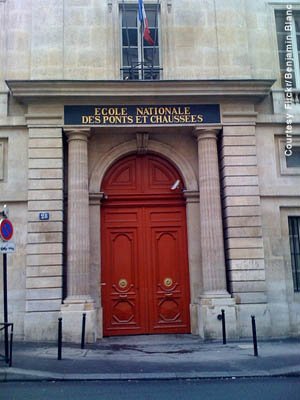Ecole Nationale Des Ponts et Chaussees
48°50'28"N, 2°35'16"E

Founded in 1747, and still operating, the Ecole Nationale Des Ponts et Chaussees is the oldest civil engineering school in the world.
Inventions credited to the Ecole Nationale des Ponts et Chaussees and its graduates include: prestressed concrete, lighting gas, and the optical lens. The school and its graduates also have been central to research in the diffraction of light, the applications of concrete, and the measurement of the strength of materials.
Responsible for the birth of many technological innovations and the education of at least one president of the French Republic and a Nobel Prize winner, the Ecole Nationale des Ponts et Chaussees is generally considered to be the first formal engineering school in the world. With more than 1,000 full-time students and 800 full- and part-time faculty members, the school today remains a vital source of engineering research and education, with a host of graduate-degree options and collaborative programs in Spain, Germany, Italy, and other countries.
In contrast to the 18th-century British tradition, wherein members of the trades and professions received their educations primarily through a system of apprenticeships, the French believed in the establishment of formal training schools, where a standard curriculum based on fundamental disciplines would be taught. It was this approach to engineering education that provided the model and inspiration to those who established formal training for American engineers at the United States Military Academy at West Point in the early 19th century.
Facts
- The Ecole Nationale des Ponts et Chaussees was first established informally in 1744 as a unit of the Corps des Ponts et Chaussees, a department of the French national government created in 1716 to supervise the building of all major roads and bridges and to oversee a national plan of highways.
- The development of the Ecole Nationale des Ponts et Chaussees was initially guided by Daniel-Charles Trudaine, who was named finance minister of France in 1743, and later supported by his son, who followed him in office. It was under Daniel-Charles Trudaine's administration that many of France's most famous stone bridges were built.
- As his chief technical advisor in the Corps des Ponts et Chaussees and the first director of the Ecole Nationale des Ponts et Chaussees, Trudaine chose Jean-Rodolphe Perronet, who later served as chief engineer of the Corps for more than 30 years. Perronet was responsible for many well known stone-arch bridges in France, including the Pont Neuilly in Paris, replaced in 1956, and the Pont de la Concorde in Paris, widened to accommodate modern traffic and still in use today on the River Seine.
- Inventions credited to the Ecole Nationale des Ponts et Chaussees and its graduates include: prestressed concrete, lighting gas, and the optical lens. The school and its graduates also have been central to research in the diffraction of light, the applications of concrete, and the measurement of the strength of materials.
- Among the school's renowned graduates are Marie-Frangois-Sadi Carnot, president of France from 1887 to 1894, and Antoine-Henri Becquerel, who shared the Nobel Prize with Pierre and Marie Curie in 1903.

